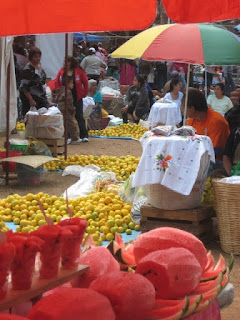Last Tuesday we drove with Eileen and Bernard Wasow to Tzintzuntzan, a nearby town where a multi-day celebration of El Señor del Rescate (rescate means "rescue") was culminating in a significant fiesta complete with bands, craft vendors, and food. The churchyard in Tzintzuntzan was full of people, and along the road we encountered many peregrinos (pilgrims) making the trip on foot from Pátzcuaro. As we got closer the numbers increased. Many people begin in the early morning because it's a multi-hour walk. Even little kids and their grandparents were hoofing it along the road.
Tzintzuntzan means "place of hummingbirds" in Purépecha, the local native language, and may refer to the sound that hummers make. It's one of the serious craft villages around the lake, with several distinctive ceramic styles, including a green glaze that I find oddly attractive. Unfortunately these are low-fired ceramics, which means they are not lead free. Some potters in Capula, another craft village, are now making vessels sin plomo, but most can't afford to invest in the high-temperature kilns needed for lead-free glazes. Tzintzuntzan is also known for its straw crafts and stone carvers.
We parked the Sube in a lot near town and walked the remainder of the way. There was a long line of combis on the edge of town, and I assume that there were equally long lines on the other entry roads, waiting to take people home at the end of the day.
The road into town was lined with stalls selling food (every time there is a crowd in Mexico there will be food vendors), ball caps, rugs, pottery, sweets, fruit cups, and special bread, among many other things. On the way back to the car we bought one of these breads, which were being baked on the spot in hot gas ovens.
The churchyard is intimately associated with Bishop Vasco de Quiroga, who established his first base here in the mid-1530s before moving it to Pátzcuaro a few years later. Tzintzuntzan was also capital of the Purépechan empire, never conquered by the nearby Aztecs despite their best efforts. Quiroga is said to have planted the first olive trees in the New World in this churchyard, some of which still exist though their venerable trunks are hollow and too feeble to produce many leaves, much less olives. On ordinary days the churchyard is serene and peaceful, but this was no ordinary day. Many stones in the churchyard and buildings were taken from the Purépecha sites that the Spanish demolished.
There were 2 big castillos in the churchyard ready to be ignited that night, and 2 quite excellent bands that alternated throughout the day. I was amused to hear a familiar Mozart composition scored for brass band with drums and cymbals. Nicely played, though.
A steady stream of pilgrims entered the church, many on their knees carrying candles. I saw a group of young women whose friends were placing pads in front of them to cushion their knees as they approached the door of the church. A family with young children came out carrying a photo of El Señor del Rescate that they pressed to each child's forehead before the husband and wife kissed it and crossed themselves. The church itself was richly decorated with banners and beautiful floral arrangements throughout, on altars and overhead, and along the walls.
Adjacent to the church, in another area of the yard, was a procession of young girls and boys dressed as kings and queens, with white robes, scarlet capes and gold and silver crowns. They walked and danced continuously, shaking golden rattles, as a small band played a repetitive tune on strings and guitar and a group of grotesquely-masked figures in black danced around them, apparently tempting and tormenting them. This continued for 20 or 30 minutes, raising a cloud of dust (it's the dry season here).
Here's a video I recorded of the virginal boys and girls and their devilish tempters.
Many vendors displayed piles of lemons, called limas (limes are called limones). We think limas are bland and tasteless, though some people like them for lemonade because you don't need to add sugar.
 |
After a few hours we had seen enough and eaten enough carnitas (delicious roast pork rolled in hot tortillas with sauce and pickled vegetables, sold by a man enthusiastically wielding a cleaver), so we walked to the car to drive back to Pátzcuaro. Many families had settled in for the day, eating and visiting and enjoying their holiday. On the way home there were still groups of peregrinos along the road, heading to the churchyard and the fiesta, though by then it had gotten pretty hot.
 |
| A little angel |
 |
| Slices of fresh pineapple, attractively displayed |
 |
| One of the two good bands that entertained the crowd |











I was there for a couple of hours, took a lot of photos, but didn't write it up in my blog.
ReplyDeletePhotos are here: http://tinyurl.com/4pxpq4x
Saludos,
Don Cuevas